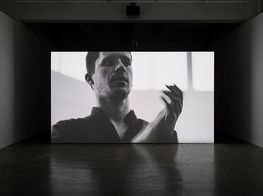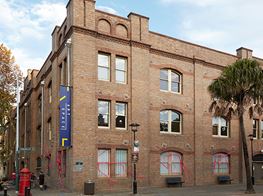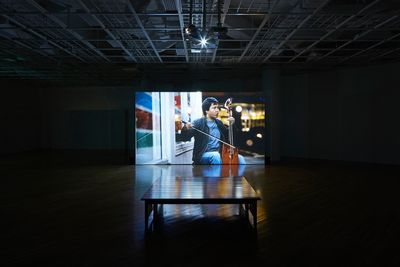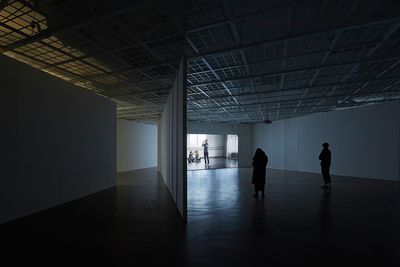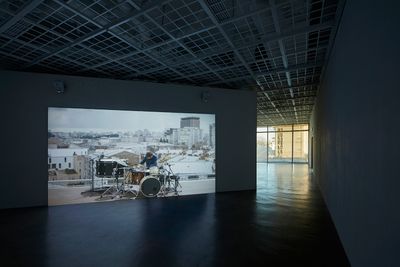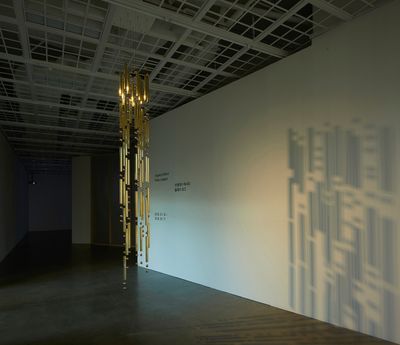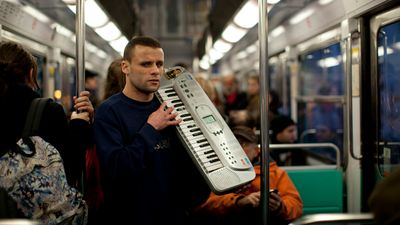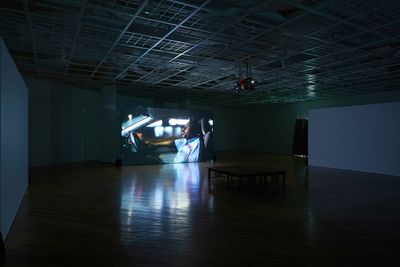Angelica Mesiti
Angelica Mesiti. Photo: Zan Wimberley.
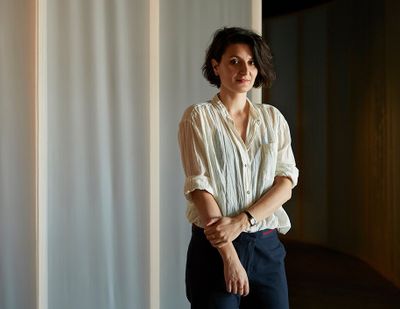
Angelica Mesiti. Photo: Zan Wimberley.
At the heart of Angelica Mesiti's practice—which moves through video, performance and installation—is an exploration of how the things that are unspoken can be used to communicate forms of expression, subjectivity, and history; and how different identities are carried through modes of language that are expressed both physically and verbally. As curator and executive director of Artspace Sydney, Alexie Glass-Kantor notes, 'Mesiti's work is about the politics of vulnerability, of humanity, of the interpersonal, of the subjective, of the felt rather than directly spoken.' Using performance, video and installation to produce forms of intimate storytelling, Mesiti's practice strives to communicate the ways in which different people feel their way through the world.
Mesiti's most recent video installations combine an understanding and passion for sound with non-linear cinematic strategies to create immersive, meditative experiences, as seen in her solo exhibition at the National Gallery of Australia in Canberra (Angelica Mesiti, Five Works, 9 September 2017–2 April 2018), which brings together five recent videos. One of these works, Citizens Band (2012), is also on view at Art Sonje Center in Seoul (Relay League, 12 January–11 February 2018); it explores the different auditory languages of four migrant musicians across Paris, Sydney and Brisbane in four chapters, revealing the passage of ephemeral traditions across different places, cultures and situations. In one scene, Loïs Geraldine Zongo, a Cameroonian woman, beats the surface of a swimming pool in Paris using a technique called akutuk, a form of aquatic percussion, and in another Bukchuluun Ganburged (Bukhu), a Mongolian throat singer, plays the morin khuur (horse-hair fiddle) on a street corner in Newtown, a neighbourhood of Sydney.
With a background in dance, Mesiti choreographs the experience of her works so that viewers are encouraged to move through the space, from one immersive experience to the next. This approach is evident in the artist's exhibition at Art Sonje Center, where, Relay League (2017), commissioned by Artspace Sydney, consists of a large, three-part video installation accompanied by one sculpture, Appel à Tous / Calling All (2017). Relay League takes as its starting point the final Morse code message transmitted by the French navy on 31 January 1997, 'Calling all. This is our final cry before our eternal silence.'
This conversation is an edited transcript of a talk that took place on 11 January 2018 at Art Sonje Center between Mesiti, Alexie Glass-Kantor and Art Sonje Center Vice Director, Haeju Kim. Mesiti discusses Relay League and Citizens Band, touching on the architecture of her installations and the intentions behind her compositions.
AKHaeju Kim: Citizens Band and Relay League are multi-channel works, one three-channel and the other four-channel. This seems to be a characteristic of your videos, that you allow each video and its subject its own designated space—for example, each musician in Citizens Band is given their own screen. Can you talk about how you format your works?
AMIn my installations, I like to work spatially, specifically thinking about how the viewer is engaging with the work, and I try to orchestrate a situation where there is a physical experience with the work, not just a passive reception. With Citizens Band, what I wanted to create was a communal setting for viewing the work so that the central point is the viewing area. And when seen in a gallery environment, the audience assembles in that space. The film rotates in a clockwise direction, so the viewer is physically moved, and through shifting in their seats; they are unconsciously engaging their bodies within that space. In the final section of the video, all of the screens become engaged and that's a moment where I feel like the audience is really held by the work, like a full-bodied embrace.
When making an installation, I think about how I can structure the work that will create a particular reception for each viewer and I find that each work dictates to me how it needs to be set up. The sequences in Relay League, although interlinked and played simultaneously, unfold like a series of episodes where each one is a peeling back, or a layer that creates a further interpretation or translation of what happened in the preceding episode. I wanted to complicate how audiences understand each work within this exhibition, as a total experience created by walking through the gallery space and arriving in front of a screen but hearing sounds from the next room, triggering them to move along to the next section. The transparent walls were also developed so that sound and light could easily move through them. When you're standing on one side, you see the flickering of the projection light on one side, which hopefully prompts you to wonder what is beyond that wall and to sort of seek it out. I'm trying to promote a kind of curious environment—that was how Relay League was developed.
AKHaeju Kim: You have noted before that the Paris terrorist attacks in January and November 2015 were a trigger for creating Relay League. How did this notion of crisis find its way into your work?
AMI wanted to contextualise what was happening in my immediate environment at that time. I was living in Paris in 2015 when we experienced the terror attacks in January at the Charlie Hebdo offices and then again in November, which happened very close to where we live. It was a very frightening experience for something like that to happen in our neighbourhood. This was also at the height of the refugee crisis in Europe and we were seeing recurring images of deaths at sea in the mainstream media, so I really felt like we were experiencing a crisis point.
Around that time, I became aware of this Morse code message, 'Calling all. This is our final cry before our eternal silence.' It really struck me that Morse code was a language that was developed for crisis situations—it's a language specifically developed for signalling distress in conflict zones as well as sending long distance messages. It occurred to me that this was an appropriate time to use this language; when I felt like we were living in a period of crisis. The phrase, 'Calling all. This is our final cry before our eternal silence,' also struck me as pertinent to the kind of ideas that I am interested in. It was the very last signal that was sent in Morse code so it was in a way the death of this language, but it was also the first time that Morse code sent a message about itself. Usually it's used to send messages in emergency situations or on behalf of others and I found it very poetic that there was a kind of tautology in this phrase—that the language was signalling its own distress.
AKAlexie Glass-Kantor: As beautiful and poetic as your works are, all of the subjects and ideas have an urgency to them, which—going back to the format of your works—necessitates movement from the viewer in order for them to be aware of their own complicity in the context and its circumstances. Therefore the body as an instrument, as a performative subject, becomes quite important in how these works are activated.
Haeju Kim: In Citizens Band, none of the subjects overlap, they each have their own space. The focus is on the facial expressions of each character so that emotions are delivered. This seems to be a big part of your work: the focus on non-verbal expression.
AMI do use a lot of close-ups, and I like to come in close with the camera. I feel like I'm often trying to approach someone to get into my work and for me, it's about trying to generate a space where we can share a moment in a very quiet, considered, open way. And I feel like when you are very close-up, so close that you can see little twitches on the face, or imperfections in the skin, or you can see how performers are becoming transported by their performance. I feel like you're more open to an empathetic or shared moment of humanity. That's how I want to unfold what's happening: by looking at a person as an individual. You might see them as part of a group that may be recognisable but in this moment they're an individual and you're considering them on their own terms.
AKHaeju Kim: Relay League is a three-channel video installation that is preceded by a sculpture, Appel à Tous / Calling All (2017): a brass and steel wind chime that visualises the aforementioned Morse code message.
There is an intended order to the videos. The first video features musician-composer Uriel Barthélémi translating that last Morse code message into a percussive score—a sound that bleeds into the rest of the installation. The second video shows two dancers, Emilia Wibron Vesterlund and Sindri Runudde, who has impaired vision. The third presents dancer Filipe Lourenço responding to Barthélémi's beats, with movements that loosely draw from folk dance vernaculars.
Despite the apparent sequencing of these works, you have mentioned that it's okay if audience's go the other way around. Could you discuss the order and narrative of this arrangement, and your decision to start with the sculpture?
AMRelay League begins with the sculpture, which is a direct, physical translation of the Morse code phrase transformed into a musical instrument; there are a series of bells that are able to sound out the phrase in a way that was never intended. I wanted to start the exhibition with that to have a very defined presence of the phrase. I've presented the work several times now and when it was first shown at Artspace in Sydney, we very specifically worked on the structure.
In terms of a sequence, from the very outset I had an idea of there being pathways inside the exhibition so the viewer could take a kind of journey. The pathways lead you from one screen to the next, and the intention was that the drummer, Uriel Barthélémi, who is interpreting the Morse code phrase, would be viewed first. I provided the drummer with the dots and dashes of the Morse code phrase and asked him if he could read it as a musical score. So what he's playing is each strike of the drum and dash of the brush—it is a direct translation of the dots and dashes of the phrase. From this he repeats that phrase over and over, elaborating it across the drum kit, using the different instruments on the drum. From that act, I then asked a dancer, Filipe Lourenço to interpret the music that Uriel had made, keeping in mind the origin of the phrase and its context. But the dancer is only really needed in order to display this haptic form of translation that takes place between Sindri and Emilia so there is an order to the work in that one scene feeds into the next and then is reinterpreted.
To your point about the order of the arrangement, I also like how in the Art Sonje Center iteration there is the possibility to work backwards, or what I consider backwards, by arriving at the dancer first and the musician last. I think if you do that, the work then has the possibility of multi-direction, which I quite like. It's important for the work to keep adapting to new situations as well; it sort of keeps it alive to do that.
AKAlexie Glass-Kantor: You're the daughter of two first generation Australians who were born to Italian migrant parents, and you have spoken about growing up in a household where your family would speak to you in Italian and you and your brother would answer in English. In a situation where you're close to people with whom you don't necessarily share a singular language, how do you find a third form—outside of that space of lapsed translation?
AMI do work outside of language a lot of the time, so either with music or with other gestural forms. And so I feel like my work can travel in a way that is accessible to people from different countries and backgrounds.
AKHaeju Kim: Citizen Band was produced in 2012. Could you discuss the context of this work? What were your circumstances in Paris at the time, and how did you come across the subjects we see in the film?
AMCitizens Band was the first work that I made when I moved to Paris in 2008: the work is separated from Relay League by five years, and it demonstrates the different way I was feeling in that city in those two different moments. Citizens Band developed out of, I guess, the feeling of being an outsider in a new city—being a foreigner and having the obstacles of language and cultural knowledge that a newcomer often finds difficult. It was from that perspective that I was made aware of how people were living in a city like Paris, which is a huge, multicultural cosmopolis. It is a city where people from all over the world live these different, often unseen lives, so the work developed out of real-life encounters I had with each subject in the work.
One of the first encounters I had was with Mohammed, who is in the video playing the Casio keyboard on the Paris Metro. I discovered him one day as I was travelling on the metro when he came on and I was immediately struck by the particular quality of his musical performance. He has a very unique voice that is untrained, with kind of a raw quality to it. There's also his physicality—Mohammed is sight impaired—so the fact that he was traversing the city on and off trains all day with that impairment, but with an incredible resilience as well, really struck me. Thirdly, there was the indifference that the people on the train displayed to him. As a newcomer in Paris and not having seen many buskers on the trains, I couldn't believe that people wouldn't take notice of him since he's so incredibly talented. Now that I've lived there for seven years, I understand the indifference, because the city wears you down and you become used to things, and you become blind to things. It's hard to stay receptive when you're being constantly confronted with difficult things.
That was the first encounter, and when I saw Mohammed, I thought, 'This is someone I'd really love to meet again'. Around that time, I was having a conversation with a friend and he was just describing this scene at his local swimming pool when he was exercising: 'I just saw the most incredible thing today. There was a woman who was standing waist-deep in the swimming pool and she was hitting the surface of the water and making this drumming sound.' When he described that scene to me, I knew I had to find her. It took me about 11 months, but I eventually found her, Geraldine, through some detective work.
After meeting both Mohammed and Geraldine, I came to understand their stories and backgrounds. I learnt that Geraldine was performing a traditional music called akutuk that is played in rivers in Cameroon, the village where she was born, and was taught to her by her grandmother. It doubles as a method of communication where messages can be sent, like signals, along the surface of the water.
The fact that Geraldine was performing akutuk in a public swimming pool in an urban centre really spoke to me. I also felt there were these links between her and Mohammed who is performing Algerian Raï music, a folk genre from Algeria. It felt like they had a relationship bound by a shared activity that returns them to where they've come from or where they can no longer be. I found that to be a really strong and pertinent kind of performance in the everyday.
I decided that I would like to make a work with them, but once I'd finished the filming, I realised that there were too many specifics about French Colonial history when these two people were combined and that's not what I wanted the focus of the work to be. I wanted to consider how musical performance and embodied culture is something that can strongly transport you so I decided that it was necessary to find two more performers from Australia, considering I live my life between Sydney and Paris. That's when I found Asim and Bukhu.
It was actually very difficult to find performers who could fit with Geraldine and Mohammed, because while they needed to be extraordinary musicians it's really the context of their performance that is so incredibly important. Asim is a Sudanese multi-instrumentalist who drives a taxi to earn a living. Where he's from in Sudan, they have a very rich tradition of whistling that related to the fact that it is forbidden to play music during the harvest period, because everyone needs to get enough rest for the long days at work. During this period, they're not allowed to play instruments, so they whistle. Asim is known in Brisbane as the whistling taxi driver.
Then there was Bukhu, who is a Mongolian throat singer and was a bit of an urban legend. He was performing in Newtown at the time, which is a really popular inner-city suburb of Sydney and it was almost strange to find him on the street because he was such an extraordinary performer. I found out he was a professional concert performer, but when he moved to Australia he had trouble making a living and ended-up busking on the street. It felt surreal to me to find this extraordinary concert performer busking for coins in this really kind of modest way.
I knew that they would complete the ensemble together, and the work is structured so that they really are viewed as discrete scenes, and although we see them as individuals and focus in on each screen, they are also part of an ensemble.—[O]

